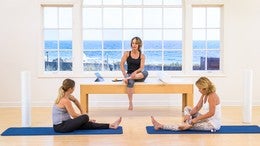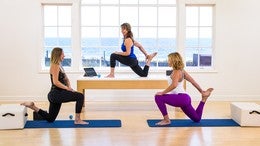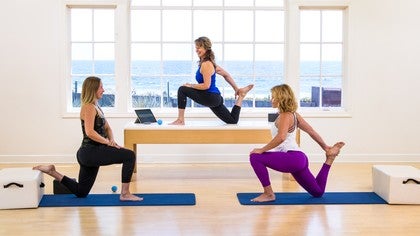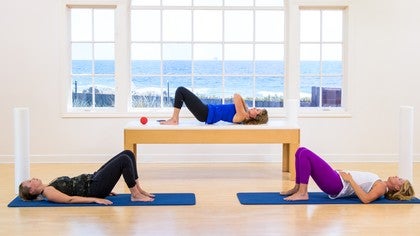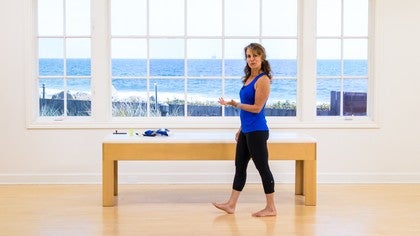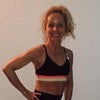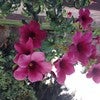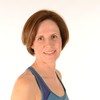Description
About This Video
Transcript
Read Full Transcript
Hi, I'm Miriam Kane and I am so glad that you're joining me for the final video of our running free dialogue. We've been discussing how we are designed to run well and without any injury and how we are born to run just like our ancestors but with a different lifestyles. We have certain roadblocks then come back and pop up. Um, we've addressed the tools for those roadblocks starting at the ankle, foot complex, the pelvis, the spine. And today we're going to talk about weaving some magic together to enjoy that running experience. So what is running, we have talked about running and today we're going to run just a little bit but just to show you from the side, the gates cycle begins when the foot strikes the ground and ends when the foot strikes the ground again. So that would be one gate cycle. If I was walking or if I was running, I'd go through it.
A bit of flight in the middle of those single foot stances where my body weight is absorbed two and a half to three times my body weight. And we have talked about the importance of having a strong and well aligned body in order to be able to have the biomechanics that encourage an injury free running experience. When we discuss the midfoot stance and that it's absorbing two and a half to three or more times our body weight, we didn't discuss what happens if we don't have that mid-foot stance as much as we're going to right now, if we don't land with a foot underneath of us, then we're landing probably with a foot ahead of us and if we do that and absorb this energy through our whole kinetic chain, it's a little bit violent. Whereas if we absorb it underneath of us, the arch of the foot is designed to take that. Okay, so let's talk a little bit about the rhythm that we can use to ensure that that happens. We can think about not foots, not heel striking or we can put ourselves in a situation where it's unlikely to happen. And I like option B because I'm busy thinking about things like holding my core together, using my transverse abdominis and trying to really enjoy as I'm scanning my body and trying to hear the messages that it's giving me.
So I'm going to show you how that would work. You can download a free metronome. I have the CI running metronome. I like it. It has some little lessons that go along with it. And so studies have proven whether we're cycling, whether we're running, we know the body loves rhythm, we have a heartbeat. Um, our fluids even have a pulse to them and, and a beat. And we found that the beats per minute of 180 seems to work very well for injury prevention just for cycling, but for running as well. That would be, we're talking about both feet, feeling what each foot is going to be doing.
So on this metronome I have it at one 60 because we're going to start gradually. If you have not been using a pace of about 160 beats per minute as a cadence, then this may seem really fast. So we'll start with one 60 and we'll move our way up and see what that feels like. So first of all, we're going to stand with our neutral alignment. Remember Your Pez dispenser, you're feet are going to be neutral. You're thinking of a slight wrap so that your pelvis is neutral and I'll show you what happens when you don't do that.
Someone kindly pointed that out to me the other day. I tend to have an anterior tilt to my pelvis. So if I'm not using my core, when I bend my knees, you can probably see what would happen to my pelvis. I go side to side. But now I'm going to dispense my Pez and bend my knees. And can you see a difference? I hope so. Okay, so that's sad. Make sure that you're well aligned. I'm going to go ahead and set the metronome for 160 beats just for a minute.
I hope you can hear that.
That'd be lift your heels and once you find that,
Notice I lose the cadence doesn't look like this. That would be a lot slower. Okay, so I'm going to turn that off for now. I had it up one 80 excuse me, I did not have it at one 80 I had it 160180190 that's your elite runners and if you're an elite runner, that's wonderful. If you have long legs, that's going to be challenging. You could start at one 60 and start to gradually progress up one 62 a few days later, maybe one 64 one 66 until you find the groove that works for you. But notice that there is no way that you're going to heel strike.
There's no way you have time to reach out with your leg. And so that's just a little marker that you can use in your running practice. You can even use music that has that beat in order and then make sure that you attach one heel lift at a time and that will help you from overstriding and heel striking. So we have talked about setting up for running free physically ourselves, giving ourselves the tools, the mobility, um, for this magic to happen that the proper musculature is able to kick in and do what it was designed to do. Those strong glutes on that toe off, right, the shoulders, being able to, the elbows going back and allowing that shoulder to open up. Well. We also have the stability and the homework that we were talking about using the Pez dispenser where we feel that our pelvis is in the proper alignment using smart movement with thought, what we call consciously focusing on our movement eventually becomes unconscious.
We start out unconsciously and dysfunctional and the way that we move, some of us certain areas, not all but some, and they don't serve as well. So then we consciously become aware of what we weren't doing that served us well. So we consciously make changes and then we're consciously moving well and then eventually we unconsciously are moving functionally. But it takes practice regarding strength of your running. Um, when we're talking gradual progression, we really mean gradual progression. It's not like, okay, I've aligned myself properly and I know that I've got all my tools in place and now I'm gonna go run a marathon. The idea is to start in increments.
We don't want to increase the frequency, the intensity or the time, the duration of our runs all at the same time. Choose one. Maybe this week I'm going to run one more time this week or I'm going to run hills or today I'm going to do a little bit more speed work. Um, and then maybe I'm going to add a little bit more time, but just one component at a time. These are things that are going to keep you healthy and running for the long run, warming up and cooling down. That's something we do very well. We're a really speedy society and it's very, very important. It's just like our vehicle's, if you have a car that you really like, you treat it well. You check the wheel alignment.
Hopefully you put some fluids in there and make sure they're there. And more than likely you would warm it up. If you have a horse that you love, you're going to warm that horse up before you go out and run and you're gonna make sure it's cooled down. So this is all we get. This is the vehicle. This is this amazing, wonderful vehicle that's going to take us through all the movements that make us happy, including running. So what would a warm up look like? You would get up, you would make sure you're hydrated. First of all, we'll talk about that in a minute and then you would warm up. You could warm up four or five minute walk, whether you're walking or whether you're running. You would do about five, eight minutes of a nice little pace. You're noticing what your body's telling you today feels like today.
Could feel like a long walk day. There's nothing wrong with that, but feeling where you might not mobilized correctly, et cetera. When you feel yourself ready, that's when you lean in and you go a little bit faster and you allow yourself to go into your run and after you've had this wonderful run, you're now going to cool down. You're allowing your lymphatic system to clean out all these, the detriment or the detritus from your run pretty much so that the next day when you go to run, you're a little bit fresher. Okay, very, very important. So you want to go for a run and then just go sit down and do nothing. Maybe we'll go through some mobility work as well. Take, use your ball, Lacrosse ball and areas that you know of of interest
Or you can just lean a little and allow a gravity will knock you off base and you'll be able to start running that way. And I would highly encourage you to do the latter. At first it's a little funny, you feel like running and then I'm going to still reach. But eventually you trust and just check yourself here you're aligned. If I'm not aligned, if I'm not using my core, when I go to lean, I'm going to do this. Okay, so pelvis is neutral, you fall and you're ready to go. Okay, great. And so I've used myself so I wouldn't get anybody else upset, but I like using this other little tool. It's a free app.
It's called the huddle h u d l technique. And you can have a friend or you can set it up yourself, take a little video of yourself and see how you are actually running and it slows down. You can go backwards, you can have lots of fun with it. I give you a decent frame. But the truth is that I found out in the frame prior to that that I was lifting my foot up a little bit more in the front. I was using a little bit too much of my anterior Tibialis, so that taught me that maybe I should really address that and I've been paying attention to it. But it also very importantly, when you stop that you don't have to be professional at looking at your, um, your analysis. Just to be able to put, pull through with your finger and stop it at any point and see what you look like when you land.
Remember the landing quite often is what's gonna get us in trouble and you'd like to have a vertical lower leg would not with your knee behind you. Certainly eventually it'll go forward, but definitely not behind on the way here. There's a lot of talk and not a whole lot. I at least I haven't seen research proving that wearing the compression sleeves is helpful, but if it feels good to you, do it. But compression socks or compression sleeves after your runs have enough research to show that that really helps again to continue the circulation that we need to clean out what we don't want in the tissues. And so I would highly encourage you to do that, but we don't want compressive shoes.
And we did touch on that briefly when we're speaking about the ankle and the foot, but that's one of the components of our lifestyle that have really not well served us. When we were babies, we had these nice, lovely splayed toes that were wider than the forefoot. And then unfortunately we got put in these lovely little blinky shoes or some kind of show and then we possibly went into tight shoes. Um, whatever shoe we chose more than likely didn't serve us very well. The more barefoot we can be, the better. Um, a tip that I've and chews are just really personal. You have to figure out what works for you. You don't need to be in a high yield sneaker when you're running, that's for sure.
But you do need to gradually progress to something that allows your forefoot to bend where it normally was designed to bend a gentleman by the name of Dr. Ray McClanahan and he's a podiatrist in I believe, Oregon. And he spoke to a gentleman by the name of Jay decree, who does some great research on runners and gave him a tip that I learned and I have to share with you. But when you go to look for a shoe, you take out the insult and you place your foot on that insole and your foot should fit on the insult. There is no part of your foot that just just fall off of the insole. Otherwise, when we're running your foot, Saul scrunched together and you don't have the splay and you're not really able to use your toes as they were designed to be used. So a great little tip that I really appreciate it. Okay. And then the way that we eat, it's really a lifestyle, right?
And there's no fun if anyone of you, and I know for myself, if I've allowed myself to become less fit than I like, and then I have to catch up. It's a lot harder than staying fit. And it's the same thing with our nutrition and say the same thing with our hydration. By the time, if you think of a, our bodies were 70 some percent water, right? And so we wonder why we feel stiff or why we feel achy and why we're all gummed together on the inside. But a good part of that could be our hydration. So what I've learned or what I've heard so far, what they're saying anyways is half of our body weight in ounces per day. And then if you sweat, which I think we probably all do, then you're going to add to that and maybe using some form of hydration.
I like none and UNM or any of you U N and it doesn't have any sugar added to it, but I'm sure you could find something at your health food store as well. And as long as it tastes good and you'll use it, that's really important. After a run, rehydrate well and eat well, eat for energy, okay, now we're styling. So now you have your tools, now you're, you're aligned and you understand where, how to use your glutes and how important they really are, how important our foot health is, how important the ability to use the spine. And the way that it's designed to be used is. And you can just be yourself when you run and when you move because that's a beautiful thing.
You see gazelles and you see gliders and there's no right and there's no wrong. But there are some certain components, those three non negotiables that apply to all of us to make it a healthy type of movement. And my license tag says breathe on it for obvious reasons. So we teach what we need, right? And I need to breathe as well. And I think as a community, we all need to breathe.
We need to slow down and we need to be. So I encourage you to use your, blow your breath when you're running. Think of the way that I breathe when I'm running as I think of exhaling for four counts because in my head now I can hear that metronome, even when it's not there and then I allow an inhale, believe you me. If you exhale everything out, you're going to inhale. You don't have to worry about whether you inhale or not. That's that other natural recoil and then you call nine one when you actually need it.
You have the tools and we're no longer afraid of those little aches and pains that we might feel because we have tools to address them, but sometimes something does crop up that we need help with and that's when you call your favorite chiropractor or physio by all means or your NKT specialist. I'm in the process of learning more about neuro kinetic therapy. I'm a student and I'm learning so much that helps me to appreciate what my body can do. We're a society that is too focused on what we look like and not appreciative enough of what we're able to do, but when we are really in a situation, we're not sure what to do. We know who to call. So have that in your tool, shed your tool chest as well and use your place principles. It applies on the mat, it applies in real life.
We should be aware and we need to breathe and be centered and have some control over what we do have control over and you know, be efficient in our movement. Finding that flow, being precise in what we're looking to do and that's going to bring harmony into our practice. I feel like we um, are we given enough to what we asked so much of our bodies are we appreciative enough and I hope that you can take this experience that we've had together and that it empowers you with these to not only have the tools but to really use those tools. I am delighted to be 56 years old. I've been running for, since I was 14 years old. You can do the math and I work with students that are nine years old and students in their sixties on as far as running older than that [inaudible] field. And I, I am inspired by the 80 year olds and 90 year olds that I see at the starting line when I do races. And that's what we're designed to do, is move. That's what's going to keep us young and healthy. It affects the way we think, our brains. So just remember that that is just a number and you're really truly, as Joseph said, we're only as young or as old as our spines and take care of yourself.
So thank you for joining me. It's been great fun for me, and I hope to see you again.
Pilates for Athletes: Running Free
Comments
You need to be a subscriber to post a comment.
Please Log In or Create an Account to start your free trial.

